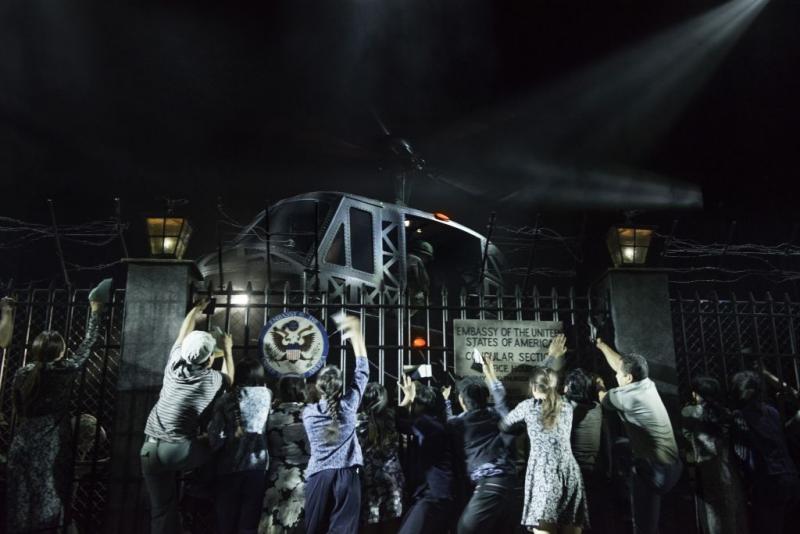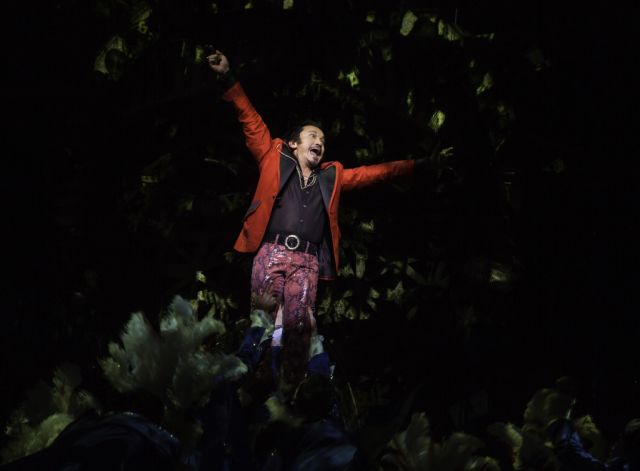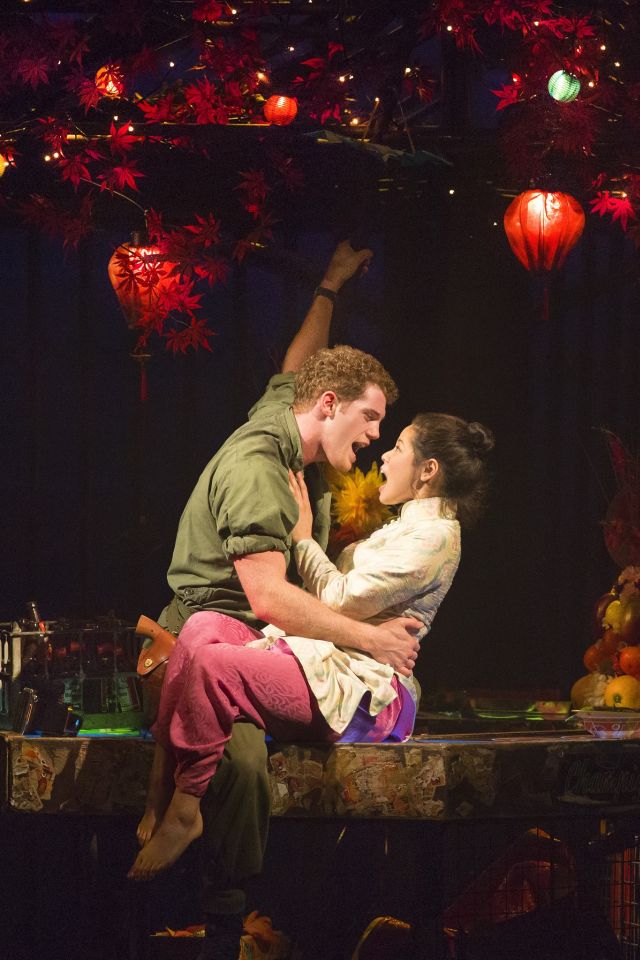Miss Saigon, Prince Edward Theatre | reviews, news & interviews
Miss Saigon, Prince Edward Theatre
Miss Saigon, Prince Edward Theatre
25 years on, Boublil and Schönberg's celebrated musical thrills anew

The heat is on in Saigon, and 25 years after its world premiere, Cameron Mackintosh has just turned up the thermostat. Boublil and Schönberg's celebrated take on Puccini's Madam Butterfly has always been my favourite of their collaborations (though I retain an enthusiasm for the pre-revised score of Martin Guerre) and there are moments in Miss Saigon where, truth be told, they trump the Italian master of romantic melodrama at his own game.
Maybe it's the ongoing proximity of America's disastrous involvement in the Vietnam war and the subsequent resonances of Iraq, but the show seems to pack more punch now than it did back in 1989 and thanks to a production from Laurence Connor that owes much to Nicholas Hytner's thrilling original, there is if anything a closer identification with the central character of The Engineer (Jon Jon Briones, pictured below), whose perception of the American dream so cynically (in the light of what we all now know) mirrors our own scepticism.
 The cleverness of the conception - and in this, the writers are truly one up on Puccini and his librettists - hinges on the critical three years separating the fall of Saigon and the establishment of Ho Chi Minh City. When the American marine Chris unexpectedly finds love in "DREAMLAND" - the Engineer's emporium for sex in the explosive heart of Saigon - his intentions towards the fragile and idealistic Kim are far more honorable than those of Pinkerton in Butterfly. it's the big "what if" at the heart of the show that really delivers the emotional punch as we flashback to the fateful night when the lovers are torn apart in the chaos of the fall of Saigon and the last helicopter departs from the roof of the Embassy.
The cleverness of the conception - and in this, the writers are truly one up on Puccini and his librettists - hinges on the critical three years separating the fall of Saigon and the establishment of Ho Chi Minh City. When the American marine Chris unexpectedly finds love in "DREAMLAND" - the Engineer's emporium for sex in the explosive heart of Saigon - his intentions towards the fragile and idealistic Kim are far more honorable than those of Pinkerton in Butterfly. it's the big "what if" at the heart of the show that really delivers the emotional punch as we flashback to the fateful night when the lovers are torn apart in the chaos of the fall of Saigon and the last helicopter departs from the roof of the Embassy.
That moment, which is to say that helicopter, has become the leitmotif for the show and was greeted with many roars of affirmation on opening night as a symbol of Miss Saigon's production values, which are writ bigger and glossier and more operatic than ever. Whatever you think of the show, and I'm clearly a diehard fan, the look and sound of it are sensational. Indeed, I don't think I've ever heard a contemporary musical sound better (the sound designer is Mick Potter) in the theatre.
Claude-Michel Schönberg's score is his lushest by far, and the way its key themes germinate and cross-fertilise and underscore the show's emotional climactics is key to the dramatic clout it exerts. The piece sounds truly exotic in William David Brohn's orchestrations - perhaps his best ever, spiced as they are with Vietnamese infusions of percussion and fragrant pipes in haunting pentatonic flights. Perhaps my favourite scene, musically and dramatically (and in this, Schönberg really does out-Puccini Puccini), is the moment where Kim reveals Chris's son ("There is a secret") to the Assistant Commisar to whom she was once promised in marriage. As his outrage turns to threat and she takes the action that will seal her fate, that melody becomes the communal voice of change - "this is the hour" - a capella, punctuated only by the crash and burn of percussion.
 The big set pieces are truly eye-popping but not at the expense of the intimacy and no-holds-barred intensity of the performances, led by American newcomer Eva Noblezada's touching Kim, whose fragility on stage belies a huge vocal and emotional range. Alistair Brammer's Chris (pictured with Noblezada left) is vibrantly contemporary and, as his friend John, Hugh Maynard pretty much stops the show with "Bui Doi" - the anthem to all the forgotten children who become illegitimate casualties of war.
The big set pieces are truly eye-popping but not at the expense of the intimacy and no-holds-barred intensity of the performances, led by American newcomer Eva Noblezada's touching Kim, whose fragility on stage belies a huge vocal and emotional range. Alistair Brammer's Chris (pictured with Noblezada left) is vibrantly contemporary and, as his friend John, Hugh Maynard pretty much stops the show with "Bui Doi" - the anthem to all the forgotten children who become illegitimate casualties of war.
Dominating proceedings with wily scepticism and a nose for survival ("I speak Uncle Ho but I think Uncle Sam") is the Engineer of Briones, a kind of Emcee whose sharp-talking pizzazz finds its apogee in the quasi-Kander and Ebb number "The American Dream" where, caught in the cross-beams of designer Bruno Poet's dazzlingly choreographed lighting, showgirls are draped from Liberty's crown and Briones gets to frott a Cadillac: better than casual sex, the number is saying, and just as meaningless.
The show ends with the most poignant slow curtain in the contemporary musical theatre, and it is a tribute to its dramatic accomplishments that notwithstanding the epic proportions and fabulous production values, the tiny lifeless figure of Miss Saigon, held one more time in her lover's embrace, shall be our most lasting memory.
The future of Arts Journalism
You can stop theartsdesk.com closing!
We urgently need financing to survive. Our fundraising drive has thus far raised £49,000 but we need to reach £100,000 or we will be forced to close. Please contribute here: https://gofund.me/c3f6033d
And if you can forward this information to anyone who might assist, we’d be grateful.

Subscribe to theartsdesk.com
Thank you for continuing to read our work on theartsdesk.com. For unlimited access to every article in its entirety, including our archive of more than 15,000 pieces, we're asking for £5 per month or £40 per year. We feel it's a very good deal, and hope you do too.
To take a subscription now simply click here.
And if you're looking for that extra gift for a friend or family member, why not treat them to a theartsdesk.com gift subscription?
more Theatre
 Troilus and Cressida, Globe Theatre review - a 'problem play' with added problems
Raucous and carnivalesque, but also ugly and incomprehensible
Troilus and Cressida, Globe Theatre review - a 'problem play' with added problems
Raucous and carnivalesque, but also ugly and incomprehensible
 Clarkston, Trafalgar Theatre review - two lads on a road to nowhere
Netflix star, Joe Locke, is the selling point of a production that needs one
Clarkston, Trafalgar Theatre review - two lads on a road to nowhere
Netflix star, Joe Locke, is the selling point of a production that needs one
 Ghost Stories, Peacock Theatre review - spirited staging but short on scares
Impressive spectacle saves an ageing show in an unsuitable venue
Ghost Stories, Peacock Theatre review - spirited staging but short on scares
Impressive spectacle saves an ageing show in an unsuitable venue
 Hamlet, National Theatre review - turning tragedy to comedy is no joke
Hiran Abeyeskera’s childlike prince falls flat in a mixed production
Hamlet, National Theatre review - turning tragedy to comedy is no joke
Hiran Abeyeskera’s childlike prince falls flat in a mixed production
 Rohtko, Barbican review - postmodern meditation on fake and authentic art is less than the sum of its parts
Łukasz Twarkowski's production dazzles without illuminating
Rohtko, Barbican review - postmodern meditation on fake and authentic art is less than the sum of its parts
Łukasz Twarkowski's production dazzles without illuminating
 Lee, Park Theatre review - Lee Krasner looks back on her life as an artist
Informative and interesting, the play's format limits its potential
Lee, Park Theatre review - Lee Krasner looks back on her life as an artist
Informative and interesting, the play's format limits its potential
 Measure for Measure, RSC, Stratford review - 'problem play' has no problem with relevance
Shakespeare, in this adaptation, is at his most perceptive
Measure for Measure, RSC, Stratford review - 'problem play' has no problem with relevance
Shakespeare, in this adaptation, is at his most perceptive
 The Importance of Being Earnest, Noël Coward Theatre review - dazzling and delightful queer fest
West End transfer of National Theatre hit stars Stephen Fry and Olly Alexander
The Importance of Being Earnest, Noël Coward Theatre review - dazzling and delightful queer fest
West End transfer of National Theatre hit stars Stephen Fry and Olly Alexander
 Get Down Tonight, Charing Cross Theatre review - glitz and hits from the 70s
If you love the songs of KC and the Sunshine Band, Please Do Go!
Get Down Tonight, Charing Cross Theatre review - glitz and hits from the 70s
If you love the songs of KC and the Sunshine Band, Please Do Go!
 Punch, Apollo Theatre review - powerful play about the strength of redemption
James Graham's play transfixes the audience at every stage
Punch, Apollo Theatre review - powerful play about the strength of redemption
James Graham's play transfixes the audience at every stage
 The Billionaire Inside Your Head, Hampstead Theatre review - a map of a man with OCD
Will Lord's promising debut burdens a fine cast with too much dialogue
The Billionaire Inside Your Head, Hampstead Theatre review - a map of a man with OCD
Will Lord's promising debut burdens a fine cast with too much dialogue

Add comment